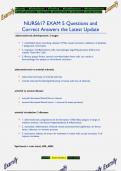#Examify | #OnlineExams | #TestPrep | #StudyResources | #AcademicSuccess |
#ExamPreparation | #QuizTime | #LearningTools | #Education | #StudentSupport
NURS617 EXAM 5 Questions and
Correct Answers the Latest Update
atherosclerosis development: 3 stages
✓ 1. endothelial injury (smoking, obesity, HTN); causes increase in adhesion of platelets
+ phagocytic monocytes
✓ 2. migration of inflammatory cells; macrophages engulf lipoproteins (LDLs) and
creates "foam-like" cells
✓ 3. fibrous plaque forms; central core=lipid-laden foam cells. can result in
hemmorhage into plaque or thrombotic occlusion
atherosclerosis vs arterial sclerosis
✓ atherosclerosis=type of arterial sclerosis
✓ arterial sclerosis=hardening/thickening of vessel wall; loss of elasticity
arterial vs venous disease
✓ arterial=decreased blood flow to tissues
✓ venous=decreased blood return + removal of waste products
arterial circulation: 3 diseases
✓ 1. atherosclerosis: progressive dx d/t formation of fibrofatty plaques in large or
medium arteries. risk factors=hyperlipidemia & inflammation
✓ 2. vasculities: inflammation of blood vessels (arteries/veins/capillaries); d/t direct
injury, infection, or immune process
✓ 3. aneurysms: dilation of artery d/t weakness in vessel wall; as size increases, % of
rupture increases
lipid levels + role: total, LDL, HDL
Examify | Smart Grades | Latest update
,#Examify | #OnlineExams | #TestPrep | #StudyResources | #AcademicSuccess |
#ExamPreparation | #QuizTime | #LearningTools | #Education | #StudentSupport
✓ total: <200 (high risk=240+)
✓ LDL: <100; carries cholesterol to peripheral tissues
✓ HDL: 40+; protective; removes cholesterol from tissues to liver for disposal
✓ **liver=major role in LDL metabolism; poor liver function=increased LDLs
atherosclerosis: risk factors + arteries effected
✓ -HTN, smoking, AA race, diabetes, age, genetic predisposition (low LDL
receptors=increase risk d/t increased need for macrophages to digest lipids; forms
foam cells)
✓ -birth control, HIV meds, beta-blockers, estrogens
✓ -arteries supplying heart, brain, kidneys, lower extremities, small intestine
athersclerosis: 3 types of lesions
✓ 1. fatty streak - yellow
✓ 2. fibrous plaque - grey/pearly
✓ 3. complicated lesion - scar tissue, ulceration, thrombosis risk
Giant Cell Arteritis (Temporal Arteritis)
✓ -granulomatous inflammation of aorta + its major branches (ex: carotid);
autoimmune panarteritis d/o frequently affecting the temporal artery (lupus, RA)
✓ -s/s: blurred vision or diplopia, fever, myalgia, arthralgia. increased CRP & ESR
✓ -risk for aortic aneurysm
✓ -tx: high dose corticosteroids
acute arterial occlusion
Examify | Smart Grades | Latest update
,#Examify | #OnlineExams | #TestPrep | #StudyResources | #AcademicSuccess |
#ExamPreparation | #QuizTime | #LearningTools | #Education | #StudentSupport
✓ -sudden blockage of an artery, typically in the lower extremity (tibial, pedal,
peroneal), in the patient with chronic peripheral arterial disease
✓ -50% narrowing of artery until s/s appear
✓ -s/s: intermittent claudication (pain w/ walking that resolves w/ rest), pallor, shiny
skin w/o hair, weak pedal pulse, cool to touch, sores that wont heal
✓ -dx: lower systolic BP in ankle than brachial, doppler ultrasound
✓ -tx: aspirin, plavix; NO NICOTINE OF ANY KIND
thrombroangitis obliterans/burger disease
✓ -inflammatory arterial disorder that causes thrombus formation; effects medium
sized arteries (femoral, digital, plantar)
✓ -s/s: pain distal to arterial ischemia, intermittent claudication in arch of foot + digits,
malformed nails
✓ -extremities can turn gangrene & require amputation
✓ **NO NICOTINE; TRIGGERS INFLAMMATORY RESPONSE
raynaud disease vs phenomenon + tx
✓ -intense vasospasm of arteries + arterioles in fingers, sometimes toes; ischemia
causes pallor/cyanosis
✓ -disease=precipitated by cold or extreme emotions; not a secondary disorder,
seldom causes tissue necrosis
✓ -phenomenon= can cause tissue necrosis; d/t previous tissue trauma (ex: frost bite,
heavy vibratory tools, lupus/collagen dx)
✓ -tx: vasodilators; minipress, calcium channel blockers (nifidepine, diltiazem)
aneurysms: true vs false
✓ true= bounded by a complete vessel wall; blood remains within vascular
compartment
✓ false=local dissection or tear in inner wall of artery; forms extravascular hematoma
and causes vascular enlargement; only bound by outer layers of vessel wall or
supporting tissues
aneurysms: berry vs fusiform
Examify | Smart Grades | Latest update
, #Examify | #OnlineExams | #TestPrep | #StudyResources | #AcademicSuccess |
#ExamPreparation | #QuizTime | #LearningTools | #Education | #StudentSupport
✓ -berry=small, spherical vessel dilation; usually in circle of willis
✓ -fusiform=gradual enlargement of aorta; usually abdominal or thoracic
aneurysms: causes
✓ -abnormal dilation of blood vessel; can be in artery or vein
✓ -causes=trauma, infection, atherosclerosis
aortic aneurysms
✓ -weakness in the wall of the aorta that makes it susceptible to rupture
✓ -involves any part of aorta; ascending, descending, and abdominal
✓ -abdominal=most common
✓ -usually asymptomatic; pulsing mass d/t calcification over time
✓ -risk factors: HTN, atherosclerosis, male, smoker, 50+
aortic dissection
✓ -acute, life threatening hemmorhage into blood vessel wall w/ long tearing of vessel
wall to form blood-filled channel
✓ -causes: HTN, pregnancy, connective tissue disease (marfans)
✓ -s/s: abrupt excrutiating pain, syncope, pulse unattainable in one or both arms,
paralysis of lower extremities
✓ -occurs w/o evidence of previous vessel dilation; usually thoracic or ascending aorta
factors in developing venous dx
✓ 1. level of activity in lower extremities - skeletal muscle contraction moves blood
back to heart
✓ 2. # of valves in veins to prevent retrograde of blood - less=genetic predisposition to
varicose veins
✓ 3. changes in thoracic pressure when breathing - increase in pressure (ex-
HTN)=increase risk of varicose veins
Examify | Smart Grades | Latest update




